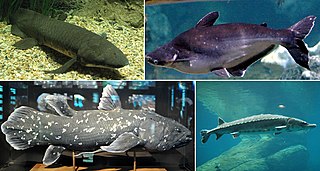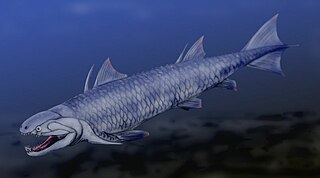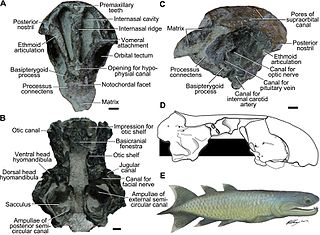
Chondrichthyes is a class that contains the cartilaginous fishes that have skeletons primarily composed of cartilage. They can be contrasted with the Osteichthyes or bony fishes, which have skeletons primarily composed of bone tissue. Chondrichthyes are jawed vertebrates with paired fins, paired nares, scales, and a heart with its chambers in series. The class is divided into two subclasses: Elasmobranchii and Holocephali.

Osteichthyes, popularly referred to as the bony fish, is a diverse taxonomic group of fish that have skeletons primarily composed of bone tissue. They can be contrasted with the Chondrichthyes, which have skeletons primarily composed of cartilage. The vast majority of fish are members of Osteichthyes, which is an extremely diverse and abundant group consisting of 45 orders, and over 435 families and 28,000 species. It is the largest class of vertebrates in existence today. The group Osteichthyes is divided into the ray-finned fish (Actinopterygii) and lobe-finned fish (Sarcopterygii). The oldest known fossils of bony fish are about 420 million years old, which are also transitional fossils, showing a tooth pattern that is in between the tooth rows of sharks and bony fishes.

The coelacanths are members of a now-rare order of fish (Coelacanthiformes) that includes two extant species in the genus Latimeria: the West Indian Ocean coelacanth primarily found near the Comoro Islands off the east coast of Africa and the Indonesian coelacanth. The name originates from the Permian genus Coelacanthus, which was the first scientifically named coelacanth.

Gnathostomata are the jawed vertebrates. The term derives from Greek: γνάθος "jaw" + στόμα "mouth". Gnathostome diversity comprises roughly 60,000 species, which accounts for 99% of all living vertebrates. In addition to opposing jaws, living gnathostomes have teeth, paired appendages, and a horizontal semicircular canal of the inner ear, along with physiological and cellular anatomical characters such as the myelin sheaths of neurons. Another is an adaptive immune system that uses V(D)J recombination to create antigen recognition sites, rather than using genetic recombination in the variable lymphocyte receptor gene.

Sarcopterygii —sometimes considered synonymous with Crossopterygii —is a taxon of the bony fishes whose members are known as lobe-finned fishes. The group Tetrapoda, a superclass including amphibians, reptiles, and mammals, evolved from certain sarcopterygians; under a cladistic view, tetrapods are themselves considered a group within Sarcopterygii.

Acanthodii or acanthodians is an extinct class of gnathostomes, typically considered a paraphyletic group. They are currently considered to represent a grade of various fish lineages leading up to the extant Chondrichthyes, which includes living sharks, rays, and chimaeras. Acanthodians possess a mosaic of features shared with both osteichthyans and chondrichthyans. In general body shape, they were similar to modern sharks, but their epidermis was covered with tiny rhomboid platelets like the scales of holosteians. Paraphyletic groupings are problematic, as one can not talk precisely about their phylogenic relationships, their characteristic traits and literal extinction.

Teleostomi is an obsolete clade of jawed vertebrates that supposedly includes the tetrapods, bony fish, and the wholly extinct acanthodian fish. Key characters of this group include an operculum and a single pair of respiratory openings, features which were lost or modified in some later representatives. The teleostomes include all jawed vertebrates except the chondrichthyans and the extinct class Placodermi.

The Tetrapodomorpha are a clade of vertebrates consisting of tetrapods and their closest sarcopterygian relatives that are more closely related to living tetrapods than to living lungfish. Advanced forms transitional between fish and the early labyrinthodonts, such as Tiktaalik, have been referred to as "fishapods" by their discoverers, being half-fish, half-tetrapods, in appearance and limb morphology. The Tetrapodomorpha contains the crown group tetrapods and several groups of early stem tetrapods, which includes several groups of related lobe-finned fishes, collectively known as the osteolepiforms. The Tetrapodamorpha minus the crown group Tetrapoda are the Stem Tetrapoda, a paraphyletic unit encompassing the fish to tetrapod transition.
Kenichthys is a genus of sarcopterygian fish from the Devonian period, and a member of the clade tetrapodomorpha. The only known species of the genus is Kenichthys campbelli, the first remains of which were found in China in 1993. The genus is important to the study of the evolution of tetrapods due to the unique nature of its nostrils, which provide vital evidence regarding the evolutionary transition of fish-like nostrils to the vertebrate choanae.

Psarolepis is a genus of extinct lobe-finned fish which lived around 397 to 418 million years ago. Fossils of Psarolepis have been found mainly in South China and described by paleontologist Xiaobo Yu in 1998. It is not known certainly in which group Psarolepis belongs, but paleontologists agree that it probably is a basal genus and seems to be close to the common ancestor of lobe-finned and ray-finned fishes. In 2001, paleontologist John A. Long compared Psarolepis with Onychodontiform fishes and refer to their relationships.

Polydactyly in stem-tetrapods should here be understood as having more than five digits to the finger or foot, a condition that was the natural state of affairs in the very first stegocephalians during the evolution of terrestriality. The polydactyly in these largely aquatic animals is not to be confused with polydactyly in the medical sense, i.e. it was not an anomaly in the sense it was not a congenital condition of having more than the typical number of digits for a given taxon. Rather, it appears to be a result of the early evolution from a limb with a fin rather than digits.

Guiyu oneiros is the earliest articulated bony fish discovered. The generic name Guiyu is a transliteration of the Mandarin 鬼魚 guǐyú "ghost fish" and the specific name oneiros is from Greek ὄνειρος "dream". Fossils of Guiyu have been found in what is now Qujing, Yunnan, China, in a late Silurian marine strata, about 419 million years old. Guiyu remains have been found articulated, missing only the caudal fin. The living fish is estimated to have been 33 cm long.

Ichthyostegalia is an order of extinct amphibians, representing the earliest landliving vertebrates. The group is thus an evolutionary grade rather than a clade. While the group are recognized as having feet rather than fins, most, if not all, had internal gills in adulthood and lived primarily as shallow water fish and spent minimal time on land.

Qingmenodus is a genus of prehistoric lobe-finned fish. Fossils of Qingmenodus were found in China and date back to the Early Devonian period. Qingmenodus reveals the first well-ossified otoccipital braincase in onychodonts. Palaeontologists believe that Qingmenodus was one of the oldest onychodont fish.

Fins are usually the most distinctive anatomical features of a fish. They are composed of bony spines or rays protruding from the body with skin covering them and joining them together, either in a webbed fashion, as seen in most bony fish, or similar to a flipper, as seen in sharks. Apart from the tail or caudal fin, fish fins have no direct connection with the spine and are supported only by muscles. Their principal function is to help the fish swim.

The evolution of fish began about 530 million years ago during the Cambrian explosion. It was during this time that the early chordates developed the skull and the vertebral column, leading to the first craniates and vertebrates. The first fish lineages belong to the Agnatha, or jawless fish. Early examples include Haikouichthys. During the late Cambrian, eel-like jawless fish called the conodonts, and small mostly armoured fish known as ostracoderms, first appeared. Most jawless fish are now extinct; but the extant lampreys may approximate ancient pre-jawed fish. Lampreys belong to the Cyclostomata, which includes the extant hagfish, and this group may have split early on from other agnathans.
Cosmine is a spongy, bony material that makes up the dentine-like layers in the scales of the lobe-finned fishes of the class Sarcopterygii. Fish scales that include layers of cosmine are known as cosmoid scales.

Entelognathus primordialis is a placoderm from the late Silurian of Qujing, Yunnan, 419 million years ago.
Min Naiben, also known as Nai-Ben Ming, was a Chinese materials scientist, physicist, and politician. He was a Standing Committee member of the 9th Central Committee of the Jiusan Society and vice-president of the 10th and 11th Central Committee of the Jiusan Society.

Sam Giles is a palaeobiologist at the University of Birmingham. Her research combines modern imaging with fossils to understand the evolution of life, in particular that of early fish, and in 2015 "rewrote" the vertebrate family tree. She was a 2017 L'Oréal-UNESCO Rising Star and won the 2019 Geological Society of London Lyell Fund.


















